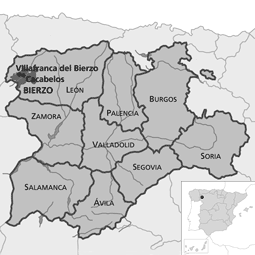 Were you nerdy about wine in 2006? If so, you probably read a few articles about Bierzo, or the indigenous grape varietal they cultivate there (Mencia). Maybe you even tasted it. (It was considered "up and coming" at the time - and perhaps it still is, though I've only ever tasted a handful of Bierzo/Mencia wines since.)
I became a fan of Mencia back then, having sampled a wine from Bierzo at my shop's annual Fall Grand Wine Tasting event. I ended up with half a case of Dominio de Tares Baltos. Since then I've fallen off the Bierzo wagon. I was simply ready for new adventures once I finished my 6 bottles.
Were you nerdy about wine in 2006? If so, you probably read a few articles about Bierzo, or the indigenous grape varietal they cultivate there (Mencia). Maybe you even tasted it. (It was considered "up and coming" at the time - and perhaps it still is, though I've only ever tasted a handful of Bierzo/Mencia wines since.)
I became a fan of Mencia back then, having sampled a wine from Bierzo at my shop's annual Fall Grand Wine Tasting event. I ended up with half a case of Dominio de Tares Baltos. Since then I've fallen off the Bierzo wagon. I was simply ready for new adventures once I finished my 6 bottles.
But as my co-worker and I continue to reevaluate and revisit the 1200 or so facings we have on our shelves, I found the Baltos again and decided to give it a whirl once more.
Bierzo is a fairly small wine-producing region located in the Northwest of Spain, quite close to Portugal. After the phylloxera epidemic killed most of the vines in the late 19th Century, economic crisis made it additionally difficult for Spanish winemaking to bounce back. But when they did in Bierzo, locals stayed true to their roots (no pun intended) and grafted Mencia vines, the dominant, native red grape varietal there. Bierzo became its own Denominacion de Origin in 1989. By then they were producing wines using more modern techniques to celebrate the best of their local varietals.
I have to admit, I was a bit disappointed when I retasted the Baltos. I was hoping for a wine with a bit of lift, as we like to say, something with red fruit flavors, a touch of earth and something... unique, I suppose. I remembered the Baltos as being distinctly versatile, pairing with a variety of foods and satisfying many people's taste buds. What I found was aromas of brett, or a barnyard essence with a touch more "funk" than simply walking into a real barn (a smell I actually cherish in a wine). Brett isn't a fault, per se (though it is controversial), but I was hoping for violets, black raspberries and sweet plums. The palate delivered a touch of black plum fruit, but its leather earthiness dominated. A gentle bite of licorice filled the back palette. The wine wasn't bad, but it wasn't doing it for me either.
Perhaps it was palette fatigue at the end of a long day tasting and evaluating 75 or so wines for the shop, but the bottom line is, I was underwhelmed.
As I discussed at the outset, Bierzo was considered an up-and-coming region just a few years ago. I write about this 'designation' often enough. The thing is, Mencia/Bierzo doesn't seem to have taken off - at least not here in Greater Boston. Frankly, I've tasted very little Mencia offerings. I'm not in a position to judge them as a whole one way or the other. But I am curious:
How many of you are familiar with the Mencia grape and what is your experience with these wines?
